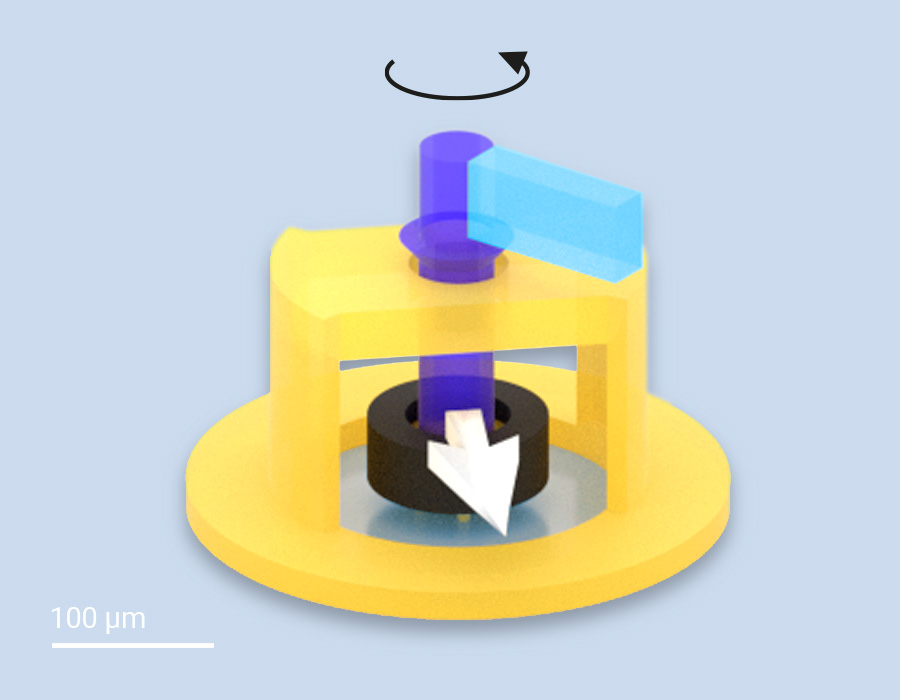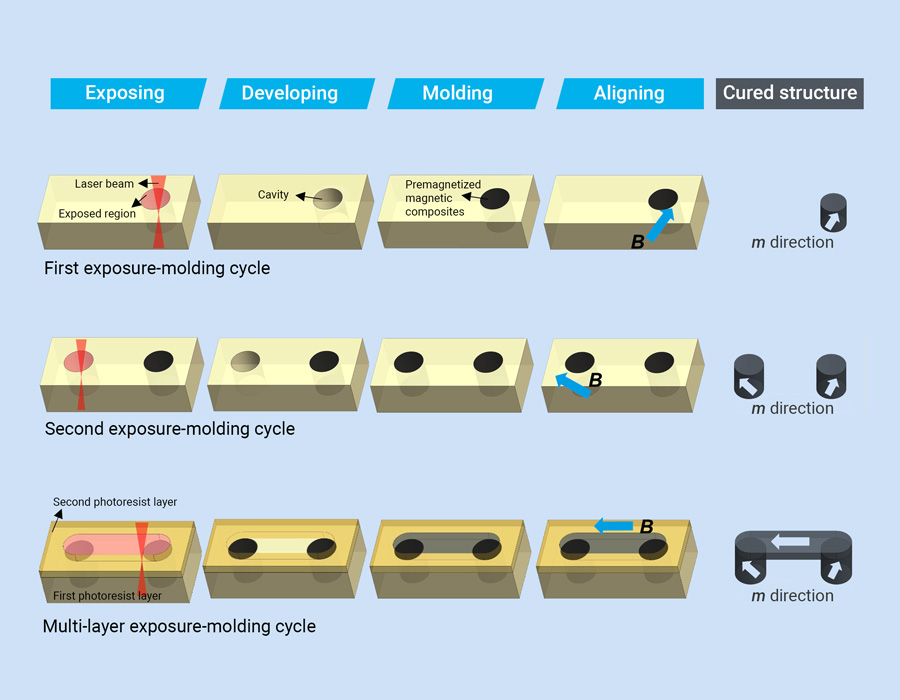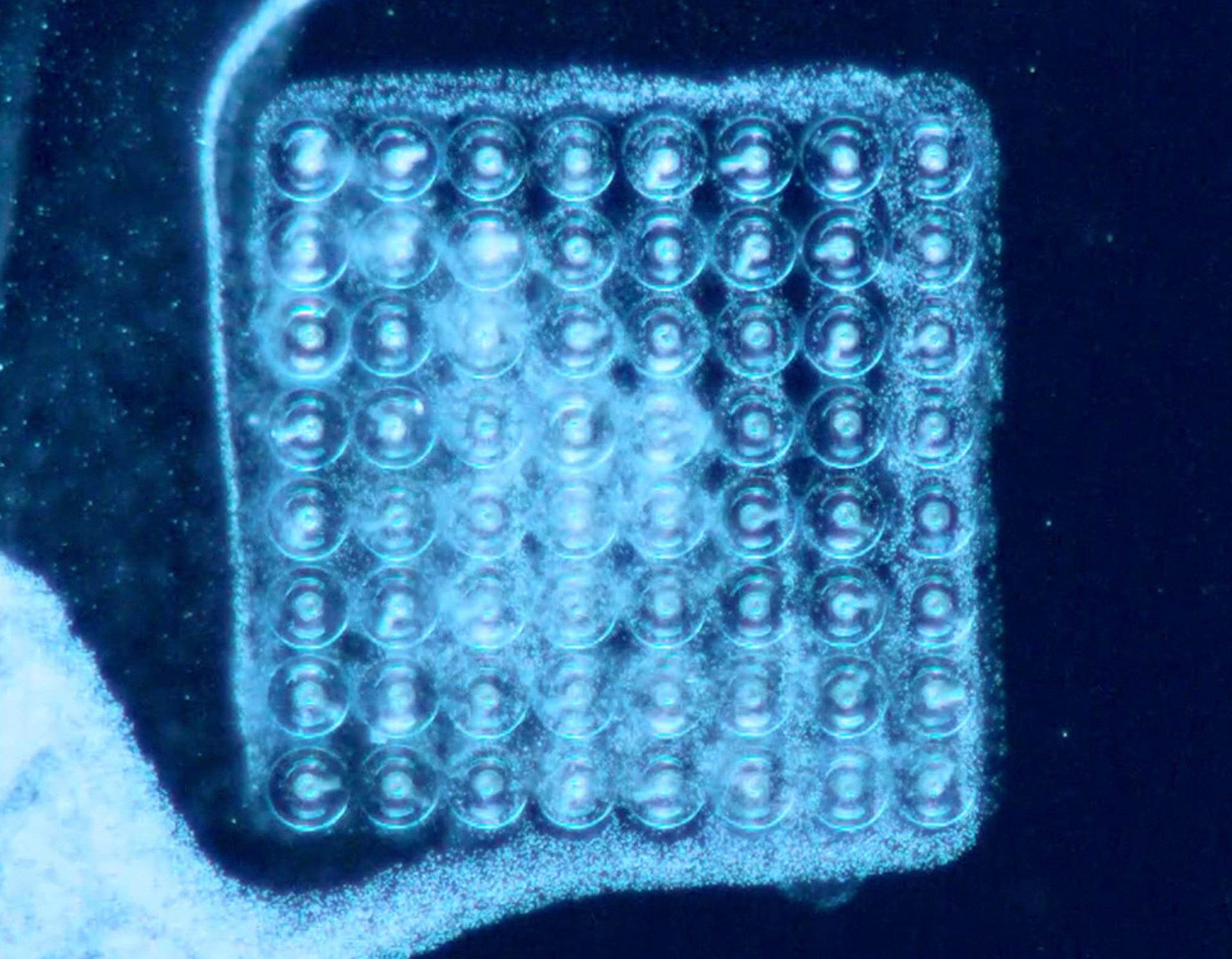Wireless miniature devices, less than half a millimeter in size, that can move and perform tasks in a controlled way are promising tools in healthcare, microfluidics, and robotics. Magnetically driven microdevices attract a strong interest due to their fast response, their operation precision, functionality and compact size. However, the simultaneous integration of different functional materials in one magnetic microdevice, with different 3D magnetization profiles and in complex 3D geometries is a major challenge. With the goal to fabricate advanced magnetic microdevices, scientists developed an innovative microfabrication strategy called molding-integrated direct laser writing. It is based on Nanoscribe’s Two-Photon Polymerization technology and, as a special feature, positive tone photoresists are used to fabricate the negative templates for molding.
Novel 2PP-based microfabrication enables making of wireless, functional microdevices
It sounds like science fiction, but miniature wireless robots promise to conquer the future of microscale manipulation, in medicine, microfluidics and many other applications. The efficient and responsive manipulation on the microscale comprises the control of microobjects, including cells, tissues, particles, microorganisms, fluids in very small quantities, and more. Potentially, the capabilities of mobile or wireless microdevices could be applied, for example, in cell micromanipulation, microsurgery, biopsy applications, drug discovery and drug delivery.
However, it is a real challenge to configure the shape and motion of tiny functional microdevices to perform specific tasks. Magnetically powered and controlled microdevices have proven to have advantages in how they rapidly respond to stimulation, how precisely they can carry out tasks on the microscale and how small they can be. Due to the complex motion and design of the envisioned microrobots, new and more elaborated microfabrication strategies are necessary to integrate heterogeneous materials with different magnetization profiles in one design. A scientists team from the Max Planck Institute for Intelligent Systems, the ETH Zürich, the Vanderbilt University and the Koç University investigate and propose a novel strategy to build wireless magnetically driven microdevices. The microdevices move in a controlled way and their movement is programmable in all three dimensions. The research project is featured in a Nature Communications publication.
Multi-step molding on positive tone photoresist templates
The starting point of the new microfabrication strategy is the use of a positive tone photoresist to fabricate negative templates for molding. First, the positive tone resist is spin-coated and baked to form a solid film. Nanoscribe’s Two-Photon Polymerization (2PP) technology is used to expose the positive tone resist using its maskless lithography capabilities. A post-exposure bake completes the photoreaction. The exposed areas are then removed during the post-print development. What remains are cavities that form a negative mold to be filled with an elastomer composite and pre-magnetized microparticles with high magnetic microparticle concentrations. Their individual magnetization direction can be programmed as required.
The key of the microfabrication strategy is the multi-step exposure of the same unexposed positive tone photoresist film that is still photoreactive. Thus, the molding cycle is repeated, aligning in each step the magnetic materials with different programmed directions in all spatial directions tuning the mobility and performance of the final magnetic microdevices. What is more, the scientists prepare multiple photoresist films to mold complex 3D structures with heterogenous materials. After all molding cycles, the photoresist film is dissolved, leaving only the final molded structures.
2PP opens up a novel microfabrication strategy
In the multi-step molding process, Nanoscribe’s 2PP technology facilitates 3D Microfabrication in positive tone photoresist to create negative molds for casting with magnetic elastomeric composites. In addition, 2PP is also exploited for 3D printing microstructures in a negative tone photoresin. The 3D-printed structures are precisely aligned relative to preexisting parts. Thus, the soft magnetic composite elements seamlessly integrate with 2PP-printed structural parts to form complex microdevice designs.
The novel microfabrication strategy is showcased with different microdevices that perform unique motions and functionalities, e.g. magnetic microrotors for mixing fluids, multi-degrees of freedom rotary systems, and magnetic micromechanical bits (µM-bits). µM-bits are reversible metamaterials that can be programmed to switch between two mechanical states.
Innovative microrotors for mixing fluids
Complex 3D rotation was also part of the investigation of mobile microdevices. Thus, magnetic micro-rotors were fabricated using the above-described microfabrication strategy. The rotating motion at the micrometer scale exhibit a phase-coordinated performance that is triggered by an in-plane rotating magnetic field.
The microrotors consist of a directly 3D-printed rigid body, made of Nanoscribe’s IP-S negative resin, and measure 360 µm in diameter and 250 µm in height. The rotor ring is made of a magnetic NdFeB-elastomeric composite and is bonded in a surrounding 3D-printed IP-S central base.
An 8x8 microrotor array programmed with a π/4 phase difference between each row and column is fabricated for demonstration. Moreover, the functionality of the microrotors was demonstrated for transporting and mixing fluids using a rotating magnetic field of 40 Millitesla.



Are you interested to read the scientific publication about how to fabricate wireless magnetic microdevices? Find the open-access publication here: Creating three-dimensional magnetic functional microdevices via molding-integrated direct laser
This and further scientific publications on more than a thousand research projects from Nanoscribe customers and system users can be found in a powerful database with a keyword search in the Premium Resources section. Register for free to see for yourself the potential of Nanoscribe’s 3D Microfabrication technology for innovative applications and fundamental innovations in many areas, and to evaluate its suitability for your project.
Video information
Video 1: An 8x8 magnetic microrotor array was fabricated using the novel 2PP-based microfabrication process. Here, the microrotors are in operation under a 15-Millitesla magnetic field rotating at 0.8 Hz in the image plane.
Video 2: The microrotor array is in operation under a magnetic field of 40 Millitesla rotating at a frequency of 5.8 Hz in the image plane. The structures showcase the capability to transport and mix fluids. The rotating speed shown in this video is 5x the actual speed of the micro-rotors.
Video and images source: CC BY 4.0., Zemin Liu, Meng Li, et al., Nature Communications 13, 2016 (2022), doi:10.1038/s41467-022-29645-2. The videos and images were adapted for the required formats.

